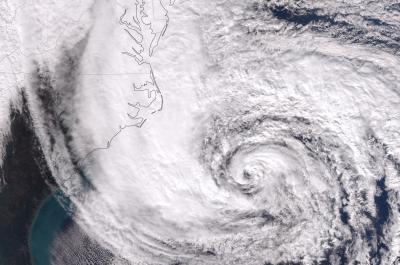The criticism of wind farms is that they are expensive, don't product enough electricity to be meaningful and change the weather patterns even a thousand miles away.
That may have a benefit; they may weaken hurricanes before landfall.
Imagine a 2012 US presidential election without New York City media whipping up a "Super Storm" and implying that Republican candidate Mitt Romney would cause hurricanes? He still would have lost but it would have given environmentalists one less reason to be against protecting people by embracing common-sense changes like waterproof subway doors and a seawall.
A new paper in Nature Climate Change says that even more offshore wind turbines could reduce hurricanes' wind speeds, wave heights and flood-causing storm surges. Yes, drastically and unpredictably changing natural weather patterns to generate electricity can be a good thing, as long as it doesn't involve coal.
The authors estimated the global potential for wind power, taking into account that as turbines are generating electricity they are also siphoning off some energy from the atmosphere. They believe that there is more than enough wind to support worldwide energy demands with a negligible effect on the overall climate. A recent paper in Nature Communications also absolved wind turbines for their dramatic changes in weather patterns.
In the new paper, the researchers modeled how the turbines' wind extraction might affect hurricanes. Unlike normal weather patterns that make up global climate over the long term, hurricanes are unusual, isolated events that behave very differently. Thus, the authors hypothesized that a hurricane might be even more affected by wind turbines than are normal winds.
Using a climate-weather simulation, the researchers simulated storms of varying size - Katrina, Isaac and Sandy - to examine what would happen if large wind farms, with tens of thousands of turbines, had been offshore in the storms' paths. Sandy was not a hurricane when it reached New Jersey, while Isaac was a Category 1 hurricane by the time it reached land. Katrina was a category 3 hurricane when it hit the northern Gulf coast.
They found that, as the hurricanes approached, a wind farm that makes weather unpredictable would do more good than harm in that case, removing energy from the storm's edge and slowing down the fast-moving winds. The lower wind speeds at the hurricane's perimeter would gradually trickle inwards toward the eye of the storm.

A new simulation says that an offshore wind farm could have weakened the tropical "Superstorm" Sandy, shown here on Oct. 28, 2012. Credit: NASA Earth Observatory image by Jesse Allen, using Suomi NPP VIIRS data provided by Cooperative Institute for Meteorological Satellite Studies (CIMSS).
The highest reductions in wind speed were by up to 87 mph for Sandy and 92 mph for Hurricane Katrina.
According to their computer model, the reduced winds would in turn lower the height of ocean waves, reducing the winds that push water toward the coast as storm surge. The wind farm decreased storm surge — a key cause of flooding — by up to 34 percent for Hurricane Sandy and 79 percent for Hurricane Katrina.
Wouldn't hurricanes damage the wind turbines, though?
Wind turbines are really expensive so using them to blunt the occasional hurricane doesn't seem fiscally prudent but the authors say that while the wind farms would not completely dissipate a hurricane, they do believe the milder winds would also prevent the turbines from being damaged.
Turbines are designed to keep spinning up to a certain wind speed, above which the blades lock and feather into a protective position. The study showed that wind farms would slow wind speeds so that they would not reach that threshold.
Their model suggests that offshore wind farms could be an alternative protective measure to seawalls, which do not generate energy. But does it make economic sense? They estimated that the costs and benefits of offshore wind farms as storm protection would be less than the net cost of generating electricity with fossil fuels - but they included fuzzy, unsubstantiated metrics like the health costs of climate change, whatever that means, and they assume mandates and subsidies will result in a miracle of capitalism and lead to very large wind farms, with tens of thousands of turbines - much, much larger than commercial wind farms today.
"This is a paradigm shift," said senior author Willett Kempton. "We always think about hurricanes and wind turbines as incompatible. But we find that in large arrays, wind turbines have some ability to protect both themselves and coastal communities, from the strongest winds."
Citation: Mark Z. Jacobson, Cristina L. Archer, Willett Kempton, 'Taming hurricanes with arrays of offshore wind turbines', Nature Climate Change 4, 195–200 (2014) 26 February 2014 doi:10.1038/nclimate2120





Comments